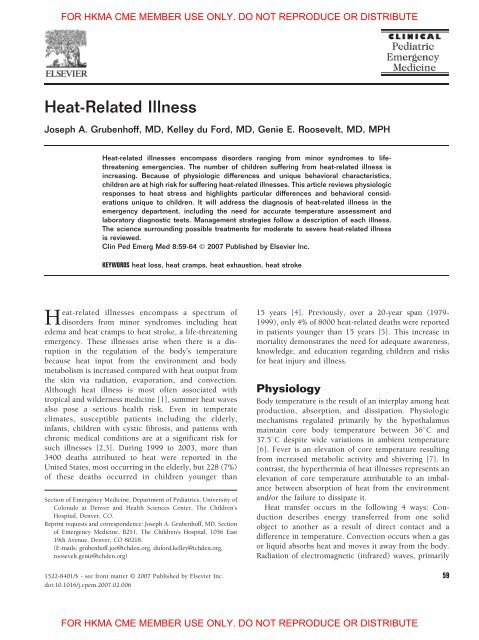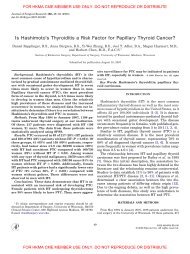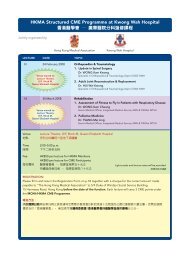Heat-Related Illness - Hkmacme.org
Heat-Related Illness - Hkmacme.org
Heat-Related Illness - Hkmacme.org
Create successful ePaper yourself
Turn your PDF publications into a flip-book with our unique Google optimized e-Paper software.
FOR HKMA CME MEMBER USE ONLY. DO NOT REPRODUCE OR DISTRIBUTE<br />
<strong>Heat</strong>-<strong>Related</strong> <strong>Illness</strong><br />
Joseph A. Grubenhoff, MD, Kelley du Ford, MD, Genie E. Roosevelt, MD, MPH<br />
<strong>Heat</strong>-related illnesses encompass disorders ranging from minor syndromes to lifethreatening<br />
emergencies. The number of children suffering from heat-related illness is<br />
increasing. Because of physiologic differences and unique behavioral characteristics,<br />
children are at high risk for suffering heat-related illnesses. This article reviews physiologic<br />
responses to heat stress and highlights particular differences and behavioral considerations<br />
unique to children. It will address the diagnosis of heat-related illness in the<br />
emergency department, including the need for accurate temperature assessment and<br />
laboratory diagnostic tests. Management strategies follow a description of each illness.<br />
The science surrounding possible treatments for moderate to severe heat-related illness<br />
is reviewed.<br />
Clin Ped Emerg Med 8:59-64 ª 2007 Published by Elsevier Inc.<br />
KEYWORDS heat loss, heat cramps, heat exhaustion, heat stroke<br />
<strong>Heat</strong>-related illnesses encompass a spectrum of<br />
disorders from minor syndromes including heat<br />
edema and heat cramps to heat stroke, a life-threatening<br />
emergency. These illnesses arise when there is a disruption<br />
in the regulation of the body’s temperature<br />
because heat input from the environment and body<br />
metabolism is increased compared with heat output from<br />
the skin via radiation, evaporation, and convection.<br />
Although heat illness is most often associated with<br />
tropical and wilderness medicine [1], summer heat waves<br />
also pose a serious health risk. Even in temperate<br />
climates, susceptible patients including the elderly,<br />
infants, children with cystic fibrosis, and patients with<br />
chronic medical conditions are at a significant risk for<br />
such illnesses [2,3]. During 1999 to 2003, more than<br />
3400 deaths attributed to heat were reported in the<br />
United States, most occurring in the elderly, but 228 (7%)<br />
of these deaths occurred in children younger than<br />
Section of Emergency Medicine, Department of Pediatrics, University of<br />
Colorado at Denver and Health Sciences Center, The Children’s<br />
Hospital, Denver, CO.<br />
Reprint requests and correspondence: Joseph A. Grubenhoff, MD, Section<br />
of Emergency Medicine, B251, The Children’s Hospital, 1056 East<br />
19th Avenue, Denver, CO 80218.<br />
(E-mails: grubenhoff.joe@tchden.<strong>org</strong>, duford.kelley@tchden.<strong>org</strong>,<br />
roosevelt.genie@tchden.<strong>org</strong>)<br />
15 years [4]. Previously, over a 20-year span (1979-<br />
1999), only 4% of 8000 heat-related deaths were reported<br />
in patients younger than 15 years [5]. This increase in<br />
mortality demonstrates the need for adequate awareness,<br />
knowledge, and education regarding children and risks<br />
for heat injury and illness.<br />
Physiology<br />
Body temperature is the result of an interplay among heat<br />
production, absorption, and dissipation. Physiologic<br />
mechanisms regulated primarily by the hypothalamus<br />
maintain core body temperature between 368C and<br />
37.58C despite wide variations in ambient temperature<br />
[6]. Fever is an elevation of core temperature resulting<br />
from increased metabolic activity and shivering [7]. In<br />
contrast, the hyperthermia of heat illnesses represents an<br />
elevation of core temperature attributable to an imbalance<br />
between absorption of heat from the environment<br />
and/or the failure to dissipate it.<br />
<strong>Heat</strong> transfer occurs in the following 4 ways: Conduction<br />
describes energy transferred from one solid<br />
object to another as a result of direct contact and a<br />
difference in temperature. Convection occurs when a gas<br />
or liquid absorbs heat and moves it away from the body.<br />
Radiation of electromagnetic (infrared) waves, primarily<br />
1522-8401/$ - see front matter ª 2007 Published by Elsevier Inc. 59<br />
doi:10.1016/j.cpem.2007.02.006<br />
FOR HKMA CME MEMBER USE ONLY. DO NOT REPRODUCE OR DISTRIBUTE
60<br />
FOR HKMA CME MEMBER USE ONLY. DO NOT REPRODUCE OR DISTRIBUTE<br />
from the sun itself, accounts for most of the heat absorbed<br />
from the environment. Evaporation is the change from a<br />
liquid to a gaseous (higher energy) phase. Of these<br />
4 mechanisms, radiation and evaporation account for<br />
most of the heat transfer in humans [6,8]. Because the<br />
ability to dissipate heat via radiation decreases as ambient<br />
temperature increases, convection gains greater importance<br />
in preventing heat-related illness. Convection and<br />
evaporation are directly controlled by innate physiologic<br />
responses, namely, circulatory dynamics and sweating.<br />
<strong>Heat</strong> Loss via Circulatory Changes<br />
The skin has a large vascular supply that provides an<br />
effective means of dissipating heat. In adults, blood flow<br />
may vary tremendously given environmental and host<br />
conditions. In severe hypovolemic states, blood flow may<br />
be near zero; however, blood flow to the skin has the<br />
potential to consume as much as 30% of total cardiac<br />
output, rivaling the flow of blood to the brain [6].<br />
Vasomotor tone modulates blood flow and, thus, heat<br />
transfer. These changes in tone may produce as much as a<br />
6-fold increase in heat conductance to the skin [9]. These<br />
marked variations in flow can alter perfusion to other<br />
<strong>org</strong>ans and contribute substantially to the pathology seen<br />
in all forms of heat illness.<br />
<strong>Heat</strong> Loss via Sweating<br />
Evaporative cooling is the most important physiologic<br />
mechanism for dissipation of heat for humans. Eccrine<br />
sweat glands, found throughout the body, can produce up<br />
to 1 to 2 L of sweat per hour [6]. If sweat does not<br />
evaporate either because of physical barriers (eg, clothing<br />
or athletic protective equipment) or high humidity,<br />
sweating results in fluid losses without a cooling effect.<br />
Sweat production also relies heavily on secretion of<br />
sodium and chloride into the sweat duct lumen. Initially,<br />
the concentration of these ions parallels that of plasma.<br />
However, the distal sweat duct reabsorbs most of the<br />
sodium and chloride with the final concentration ranging<br />
between 5 and 60 mEq/L depending on the degree of<br />
acclimatization [6]. The unacclimated are at a greater risk<br />
for electrolyte imbalances related to heat illness.<br />
Behavioral Responses<br />
Usually only mentioned briefly in discussions of the<br />
pathophysiology of heat-related illness, behavioral adjustments<br />
to ambient temperature account for the greatest<br />
degree of control over the balance of heat absorption and<br />
dissipation. These adjustments include activities such as<br />
seeking shade or avoiding strenuous exercise in high<br />
ambient temperatures. This makes infants and young<br />
children vulnerable to heat illness because they cannot<br />
make these decisions on their own. Two studies in<br />
preterm and term infants report decreased motor activity<br />
and increased extensor positioning in response to higher<br />
isolette temperatures [10,11].<br />
J.A. Grubenhoff et al.<br />
Pediatric Considerations<br />
Young children mount different physiologic responses to<br />
heat stress compared with adults and thus display greater<br />
risk of suffering heat-related illness. Differences include<br />
greater surface area-to-mass ratio, higher metabolic rate,<br />
inability to increase cardiac output, greater ability to alter<br />
peripheral blood flow, lower blood volume, and lower<br />
amount of sweat produced per gland [8,12].<br />
Most of the heat absorbed during environmental stress<br />
comes from radiation. The greater relative surface areato-mass<br />
ratio of a child allows for absorption of more<br />
incident radiation being distributed to less tissue. An<br />
equivalent dose of radiation would be expected to raise<br />
core temperature more in a child than an adult.<br />
Children younger than 5 years fail to increase their<br />
cardiac output in the face of significant heat stress when<br />
compared with older children, adolescents, and adults<br />
[12]. Although their heart rate increases, their stroke<br />
volume declines. Despite this, children demonstrate a<br />
greater ability to increase blood flow to the skin<br />
compared with adults [12]. At first glance, this may seem<br />
advantageous; however, in combination with a lower<br />
blood volume, this may contribute to greater susceptibility<br />
to syncope, exhaustion, and cardiovascular collapse.<br />
Sweat production appears to be a product of both the<br />
size of sweat glands (smaller in children) and the<br />
sensitivity of the gland to heat stress (less sensitive in<br />
children). In general, prepubertal children produce less<br />
sweat than postpubertal children and adults [12]. This<br />
limits the heat-stressed child’s ability to use evaporative<br />
heat loss in the face of heat stress.<br />
Their developmental status also places children at<br />
greater risk of heat-related illness because of their<br />
inability to move independently from one environment<br />
to another. The nonambulatory and very young child<br />
depends on adult caregivers to remove him from direct<br />
sunlight or a closed automobile. They cannot regulate airconditioning<br />
units, fans, and thermostats. Adolescent<br />
athletes often succumb to the pressures of coaches to<br />
exercise in extreme temperatures with limited water<br />
breaks and in heavy protective equipment. Their perceived<br />
invincibility and lack of experience compound<br />
these factors and place them at greater risk of heatrelated<br />
illness.<br />
Pathophysiologic Changes<br />
Resulting From Severe<br />
<strong>Heat</strong> Stress<br />
Unlike febrile illnesses where the thermoregulatory<br />
mechanisms remain intact, core temperatures in severe<br />
heat illness can rise to levels that injure cells directly. As<br />
noted previously, core temperatures are typically maintained<br />
in a narrow range, in which enzymatic processes<br />
FOR HKMA CME MEMBER USE ONLY. DO NOT REPRODUCE OR DISTRIBUTE
FOR HKMA CME MEMBER USE ONLY. DO NOT REPRODUCE OR DISTRIBUTE<br />
<strong>Heat</strong>-related illness 61<br />
and the related cellular proteins function optimally. <strong>Heat</strong><br />
denatures cellular proteins leading to an interruption of<br />
metabolic processes. Disseminated intravascular coagulation<br />
(DIC) may result from direct injury to vascular<br />
endothelium, and vascular permeability may also be<br />
altered [13]. Hyperventilation produces an initial respiratory<br />
alkalosis that eventually gives way to metabolic<br />
(lactic) acidosis as direct injury to cells progresses. Most<br />
of the manifestations of shock (shock liver, oliguria and<br />
acute tubular necrosis, altered mental status, gastrointestinal<br />
mucosal injury) and the subsequent consequences<br />
of cellular injury in those tissues can be found in<br />
heat stroke.<br />
Specific <strong>Heat</strong>-<strong>Related</strong> <strong>Illness</strong>es<br />
Miliaria Rubra (Prickly <strong>Heat</strong>)<br />
This heat rash is common in infants and young children,<br />
especially during the hot and humid months of summer.<br />
Obstruction of epidermal and dermal sweat ducts, usually<br />
due to tight fitting clothes or emollients, produces an<br />
erythematous papular rash that may include pustules.<br />
Typically concentrated on the face, upper trunk, and the<br />
neck, it may also be seen on extremities. Treatment<br />
consists of wearing loose fitting clothes and removing oilbased<br />
topical lubricants.<br />
<strong>Heat</strong> Edema<br />
<strong>Heat</strong> edema is swelling of the extremities due to vasodilation<br />
and venous stasis. Predominantly involving the<br />
elderly, edema develops after prolonged periods of sitting<br />
or standing. During these periods, cutaneous vasodilation<br />
occurs and when combined with venous stasis results in<br />
accumulation of interstitial fluid in the dependent<br />
extremities. The edema is not complicated by symptoms<br />
of lymphatic disease or congenital heart disease. It is selflimiting<br />
and rarely lasts longer than a few weeks.<br />
Treatment consists of limb elevation and compressive<br />
stockings in more severe cases. Diuretics are not<br />
indicated and may potentially exacerbate fluid depletion.<br />
<strong>Heat</strong> Syncope<br />
<strong>Heat</strong> syncope is fainting secondary to insufficient cerebral<br />
perfusion during and after exertion in the heat. Volume<br />
depletion, peripheral vasodilation, and decreased vasomotor<br />
tone increase blood flow to the periphery of the<br />
body while decreasing central venous return, which leads<br />
to decreased blood flow to the central nervous system.<br />
<strong>Heat</strong> syncope most commonly occurs in elderly and<br />
poorly acclimatized individuals. Immediately after a<br />
syncopal episode, the patient’s skin may be cool and<br />
moist; transient hypotension with a weak pulse is often<br />
present. However, abnormal vital signs may not be<br />
present upon presentation to a medical facility. Core<br />
temperature is normal or slightly elevated.<br />
Treatment consists of placing the patient in a recumbent<br />
position, rest, cooling, and oral or intravenous<br />
rehydration. Patients should be thoroughly evaluated for<br />
any injuries resulting from falls. Cardiac and neurologic<br />
disease as well as other potentially serious causes for<br />
syncope should be considered in the differential diagnosis<br />
depending on the findings of the history and physical<br />
examination.<br />
<strong>Heat</strong> Cramps<br />
<strong>Heat</strong> cramps are sporadic, often severe muscle spasms,<br />
which most commonly occur in the voluntary muscles of<br />
the extremities and abdomen. They arise abruptly after<br />
vigorous exertional stress. Cramps tend to occur during<br />
rest, after work is complete, or while showering and are<br />
believed to result from electrolyte depletion [14]. They<br />
are a common occurrence during and after sporting<br />
events, or physical labor, when individuals profusely<br />
sweat and replace salt and water losses with free water<br />
without adequate salt replacement.<br />
Muscle spasms typically occur for only a few seconds at<br />
a time but may last for several minutes or longer. During<br />
spasm, cramping muscle is often palpated as a firm mass.<br />
Exposure to cold air or water and voluntary contraction or<br />
passive movement of muscles may produce a cramp. Core<br />
body temperature is usually normal, although it may be<br />
slightly elevated, and laboratory findings include hyponatremia,<br />
hypochloremia, and occasional hypokalemia<br />
with low urine sodium. An individual with heat cramps<br />
will rarely have systemic complaints, although he or she<br />
may present with signs and symptoms of heat exhaustion.<br />
Treatment of heat cramps consists of replacing fluid<br />
losses and correcting electrolyte abnormalities. Rest and<br />
increased salt intake with adequate fluid intake is usually<br />
sufficient. An oral electrolyte solution can be used. If<br />
cramps are prolonged or do not resolve with conservative<br />
measures, treatment with an intravenous infusion of 5 to<br />
10 mL/kg of normal saline over 20 minutes is recommended<br />
[14]. Appropriate management of salt balance<br />
to prevent future cramping should be discussed with<br />
the patient.<br />
<strong>Heat</strong> Exhaustion<br />
Presentation and Evaluation<br />
<strong>Heat</strong> exhaustion is an illness with relatively vague and<br />
nonspecific symptoms. On the spectrum of heat-related<br />
illness, it represents a moderate degree of compromise<br />
but may be a warning of impending heat stroke, a<br />
medical emergency. General irritability, fatigue, weakness,<br />
light-headedness, headache, increased thirst, nausea,<br />
vomiting, and muscle cramps are common<br />
symptoms. Systemic symptoms differentiate heat exhaustion<br />
from cramps. Temperature may be normal, though<br />
mild hyperthermia (b408C) is not uncommon. Core<br />
FOR HKMA CME MEMBER USE ONLY. DO NOT REPRODUCE OR DISTRIBUTE
62<br />
FOR HKMA CME MEMBER USE ONLY. DO NOT REPRODUCE OR DISTRIBUTE<br />
temperatures must be followed with rectal measurements<br />
because peripheral measurements may not be accurate.<br />
Mild tachycardia, orthostasis, and tachypnea may be<br />
noted. Sweating is typically preserved. Other physical<br />
findings include dry mucous membranes, flushed skin,<br />
and muscle tenderness.<br />
Two categories of heat exhaustion exist and differ in<br />
their etiology and time course. Water depletion (hypernatremic)<br />
heat exhaustion arises more rapidly from<br />
inadequate fluid replenishment. Salt depletion (hyponatremic)<br />
heat exhaustion results from more prolonged free<br />
water replacement with insufficient sodium intake [8].<br />
Salt depletion is more likely to occur in a child with cystic<br />
fibrosis because salt losses in their sweat do not allow<br />
them to acclimatize [14]. A basic metabolic panel may<br />
identify hypernatremic or hyponatremic states. However,<br />
purely isolated forms of either are rare [15,16]. Other<br />
general signs of dehydration may be noted in the<br />
laboratory evaluation, including elevated hematocrit<br />
and serum urea nitrogen. Elevations of transaminases,<br />
creatinine, and creatine kinase as well as acidosis should<br />
alert the physician to the possibility of heat stroke.<br />
Management<br />
The critical step in managing any heat-related illness is<br />
removal of the patient to a cool shaded environment with<br />
cessation of activity. If the scenario allows, remove<br />
clothing to improve convective and evaporative losses.<br />
These measures, in addition to the provision of oral<br />
fluids, constitute the mainstay of heat exhaustion treatment.<br />
Antipyretics play no role in the treatment of heat<br />
illness and could exacerbate injury.<br />
Significant vital sign abnormalities, vomiting, and<br />
severe or recalcitrant muscle cramps, and significant<br />
dehydration accompanying heat exhaustion warrant<br />
intravenous fluid resuscitation. Laboratory studies (basic<br />
metabolic panel) should be obtained before initiating<br />
volume expansion. Active cooling methods are typically<br />
not necessary because the mild temperature elevation is<br />
not likely to be directly toxic to cells.<br />
Once the symptoms have subsided, temperature and<br />
other vital signs have normalized, and, if present,<br />
laboratory abnormalities resolved, the patient suffering<br />
from heat exhaustion may be safely discharged. Discharge<br />
instructions should emphasize avoidance of heat stress in<br />
the following days as well as instructions on fluid and<br />
electrolyte replacement. Persistent signs and symptoms<br />
should prompt the physician to consider alternative<br />
diagnoses and possible admission.<br />
<strong>Heat</strong> Stroke<br />
<strong>Heat</strong> stroke is a medical emergency. The differentiation<br />
between heat exhaustion and heat stroke relies on a core<br />
temperature greater than 40.68C and the presence of<br />
J.A. Grubenhoff et al.<br />
central nervous system dysfunction. Although sweating is<br />
often absent, do not rely on this sign as an indication of<br />
heat stroke.<br />
Most episodes of heat stroke occur during summer heat<br />
waves where ambient temperatures and humidity remain<br />
high for several days [17,18]. Most of the mortality<br />
occurs in the elderly population, although children with<br />
febrile illnesses or those trapped in automobiles constitute<br />
other at-risk populations [18,19]. Reports indicate<br />
that even with temperate daytime temperatures (238C or<br />
738F), intravehicle temperatures can exceed 508C<br />
(1228F) [20].<br />
Types of <strong>Heat</strong> Stroke<br />
Traditionally, heat stroke has been categorized as either<br />
classic or exertional. Classic heat stroke more commonly<br />
afflicts children and the elderly and is more insidious in<br />
onset. Infants and small children are at greater risk because<br />
they cannot independently secure fluids, alter their<br />
environment, or seek medical attention with milder forms<br />
of heat illness. Fever, with its increased endogenous heat<br />
production, compounds environmental exposure.<br />
A healthy male between adolescence and middle age<br />
who is working or exercising in a hot environment<br />
typifies the victim of exertional heat stroke. Unlike the<br />
classic presentation, these individuals are often still<br />
sweating at presentation and healthy at baseline. Indeed,<br />
the ability to generate significant heat from muscle use<br />
is inextricably tied to the development of heat stroke in<br />
this population.<br />
Presentation and Evaluation<br />
Despite the mentioned distinctions, heat stroke may<br />
affect persons of all ages and health status. Systemic<br />
manifestations are present because heat stroke is a<br />
multisystem disease. The central nervous system and<br />
cardiovascular changes are the most profound and easily<br />
recognizable in the patient suffering from heat stroke.<br />
Central nervous system abnormalities include seizures,<br />
delirium, and coma in the most severe forms but more<br />
commonly include severe headache, hallucinations, irritability,<br />
and cerebellar dysfunction including ataxia.<br />
Tachycardia is typically present as physiologic mechanisms<br />
attempt to maximize heat dissipation through<br />
convection. Maximal cutaneous vasodilation steals a<br />
significant amount of blood from the vital <strong>org</strong>ans and<br />
lowers peripheral vascular resistance, placing the patient<br />
at risk for distributive shock. As in other forms of shock,<br />
hypotension is a relatively late finding in the heat stroke<br />
victim and should warn the physician of impending<br />
circulatory collapse. Hyperventilation with respiratory<br />
alkalosis, pulmonary edema, diarrhea and vomiting,<br />
oliguria, muscle spasm, and either dry hot skin or profuse<br />
sweating are other signs of heat stroke (Table 1).<br />
Laboratory evaluation may reveal numerous abnormalities.<br />
Hyper- or hyponatremia, hypokalemia, hypo-<br />
FOR HKMA CME MEMBER USE ONLY. DO NOT REPRODUCE OR DISTRIBUTE
FOR HKMA CME MEMBER USE ONLY. DO NOT REPRODUCE OR DISTRIBUTE<br />
<strong>Heat</strong>-related illness 63<br />
Table 1 Signs and symptoms of heat illness.<br />
<strong>Heat</strong> Exhaustion <strong>Heat</strong> Stroke<br />
Irritability Seizures<br />
Fatigue/weakness Delirium/hallucinations<br />
Light-headedness Ataxia<br />
Sweating +/ sweating, but hot skin<br />
Headache Headache<br />
Nausea/vomiting Nausea/vomiting/diarrhea<br />
Tachycardia Tachycardia<br />
Increased thirst Syncope<br />
Muscle cramps Hyperventilation<br />
Temperature, b408C Temperature, z408C<br />
glycemia, and azotemia may be noted on the basic<br />
metabolic panel. Elevated prothrombin time and partial<br />
thromboplastin time and decreased platelet count suggest<br />
DIC, which is more typical of exertional heatstroke<br />
[8,13]. Because of the heavy muscle activity accompanying<br />
exertional heat stroke, elevated serum creatine kinase<br />
and myoglobinuria may be seen. Elevated transaminases<br />
indicate liver injury. Elevated white blood cell counts<br />
are possible.<br />
Management<br />
As with any emergency, airway, breathing, and circulation<br />
are addressed first. Endotracheal intubation for<br />
coma, pulmonary edema, or shock is warranted. Succinylcholine<br />
should be avoided given the risk of malignant<br />
hyperthermia and myoglobinuria. Normal saline and<br />
Ringer’s lactate are appropriate resuscitative fluids;<br />
concerns for sodium imbalance can be addressed after<br />
the patient’s condition stabilizes. In severe cases of heat<br />
stroke, one may consider cooled intravenous fluids;<br />
however, no studies have evaluated their utility. Prudence<br />
should be exercised in providing parenteral fluids so as to<br />
avoid exacerbating pulmonary edema. In addition, as<br />
active cooling methods take effect, peripheral vasoconstriction<br />
will return significant blood volume to the<br />
central circulation [21]. Adjuncts include esophageal or<br />
rectal temperature probes, cardiorespiratory monitors,<br />
bladder catheterization, and an orogastric tube.<br />
After ensuring that appropriate resuscitation is underway,<br />
attention focuses on rapidly cooling the patient to<br />
reverse the hemodynamic effects and limit further<br />
injury. This begins in the field by evacuating the<br />
potential heat stroke victim to a cool and shaded area,<br />
removing clothing and assisting evaporative and convective<br />
heat dissipation with misted water and fanning<br />
if available. Ice packs may be placed where major<br />
vessels travel near the skin surface (neck, axillae, and<br />
groin), although the utility of this practice has not been<br />
firmly established.<br />
Once in a health care facility, more sophisticated<br />
modalities are used. Cool or ice water immersion and<br />
evaporative cooling are 2 widely accepted methods;<br />
however, no trials have compared these methods.<br />
Obviously, water mist with fanning is likely to be safer,<br />
better tolerated, and more comfortable for small children.<br />
In addition, submersion adds to the difficulty of managing<br />
medical instrumentation (eg, monitors, venous access<br />
devices, and endotracheal tube). If cool water immersion<br />
is implemented, continuous direct observation of the<br />
patient is mandatory. Cool water may be less uncomfortable<br />
than ice water with similar rates of cooling [16].<br />
Seizures should be managed aggressively in both prehospital<br />
and hospital settings to avoid the endogenous heat<br />
production associated with increased muscle activity.<br />
The goal of active body cooling is not normothermia<br />
but to lower body temperature enough that physiologic<br />
mechanisms may work more effectively. Once core<br />
temperature has fallen below 398C, active cooling should<br />
cease to avoid hypothermia [15]. The patient should<br />
improve clinically as the temperature returns to normal.<br />
Admission to a pediatric intensive care unit should be<br />
strongly considered given the potential sequelae of heat<br />
stroke such as renal failure, neurologic injury, pulmonary<br />
edema, and DIC. In patients that survive the acute illness,<br />
most recover completely [22].<br />
Summary<br />
Although most patients appear to recover, heat-related<br />
illness is preventable. Children are at increased risk of<br />
heat-related illness. Developmental limitations and<br />
chronic diseases compound this risk. Treating heat illness<br />
requires the physician to be cognizant of its nonspecific<br />
presenting symptoms, the populations most at risk and<br />
the potential for life-threatening complications. Prompt<br />
diagnosis and treatment are crucial.<br />
References<br />
1. Goodman T, Iserson KV, Strich H. Wilderness mortalities: a 13 year<br />
experience. Ann Emerg Med 2001;37:279283.<br />
2. Brake DJ, Bates GP. Fluid losses and hydration status of industrial<br />
workers under thermal stress working extended shifts. Occup<br />
Environ Med 2003;60:132729.<br />
3. Hoffman JL. Environmental emergencies. <strong>Heat</strong>-related illness in<br />
children. Clin Pediatr Emerg Med 2001;2:203210.<br />
4. Centers for Disease Control and Prevention. <strong>Heat</strong>-related deaths—<br />
United States 1999-2003. MMWR Morb Mortal Wkly Rep 2006;55:<br />
79628.<br />
5. Centers for Disease Control and Prevention. <strong>Heat</strong>-related deaths—<br />
four states, July-August 2001 and United States, 1979-1999. MMWR<br />
Morb Mortal Wkly Rep 2002;51:567270.<br />
6. Guyton AC, Hall JE. Energetics, metabolic rate and regulation of<br />
body temperature. Human physiology and mechanics of disease,<br />
6th ed. Philadelphia: WB Saunders and Co; 1997.<br />
7. Bernheim HA, Brock LH, Atkins E. Fever: pathogenesis, pathophysiology<br />
and purpose. Ann Intern Med 1979;91:261270.<br />
8. Mellor MF. A <strong>Heat</strong>-induced illnesses. In Barkin RM, editor.<br />
Pediatric emergency medicine. 2nd ed. St Louis, MO: Mosby;<br />
1997. p. 49629.<br />
9. Koroxenidis GT, Shepherd JT, Marshall RJ. Cardiovascular response<br />
to acute heat stress. J Appl Physiol 1961;16:869272.<br />
FOR HKMA CME MEMBER USE ONLY. DO NOT REPRODUCE OR DISTRIBUTE
64<br />
FOR HKMA CME MEMBER USE ONLY. DO NOT REPRODUCE OR DISTRIBUTE<br />
10. Harpin VA, Chellappah G, Rutter N. Responses of the newborn<br />
infant to overheating. Biol Neonate 1983;44:65275.<br />
11. Rutter N, Hull D. Response of term babies to a warm environment.<br />
Arch Dis Child 1979;54:178283.<br />
12. Falk B. Effects of thermal stress during rest and exercise in the<br />
paediatric population. Sports Med 1998;25:221240.<br />
13. Ang C, Dawes J. The effects of hyperthermia on human endothelial<br />
cell monolayers: modulation of thrombotic potential and permeability.<br />
Blood Coagul Fibrinolysis 1994;5:19329.<br />
14. Ewald MB, Baum CR. Environmental emergencies. In Fleisher G,<br />
Ludwig S, editors. Textbook of pediatric emergency medicine, 5th ed.<br />
Philadelphia, PA: Lippincott Williams & Wilkins; 2006. p. 1017221.<br />
15. Lugo-Amador NM, Rothenhaus T, Moyer P. <strong>Heat</strong>-related illness.<br />
Emerg Med Clin North Am 2004;22:315227.<br />
16. Khosla R, Guntupalli KK. <strong>Heat</strong>-related illnesses. Crit Care Clin<br />
1999;15:251263.<br />
J.A. Grubenhoff et al.<br />
17. Dematte JE, O’Mara K, Buescher J, et al. Near-fatal heat stroke<br />
during the 1995 heat wave in Chicago. Ann Intern Med 1998;129:<br />
173281.<br />
18. Centers for Disease Control and Prevention. <strong>Heat</strong>-related mortality—<br />
Chicago July 1995. MMWR Morb Mortal Wkly Rep 1995:57729.<br />
19. Centers for Disease Control and Prevention. <strong>Heat</strong>-related illness and<br />
death—Missouri 1998 and United States 1979-1996. MMWR Morb<br />
Mortal Wkly Rep 1999;22:469272.<br />
20. Krous HF, Nadeau JM, Fukumoto RI, et al. Environmental<br />
hyperthermic infant and early childhood death: circumstances,<br />
pathologic changes and manner of death. Am J Forensic Med Pathol<br />
2001;22:374282.<br />
21. O’Donnell Jr TF, Clowes Jr GH. The circulatory abnormalities of<br />
heat stroke. N Engl J Med 1972;287:73427.<br />
22. Shibolet S, Coll R, Gilat T, et al. <strong>Heat</strong>stroke: its clinical picture and<br />
mechanism in 36 cases. Q J Med 1967;36:525248.<br />
FOR HKMA CME MEMBER USE ONLY. DO NOT REPRODUCE OR DISTRIBUTE









